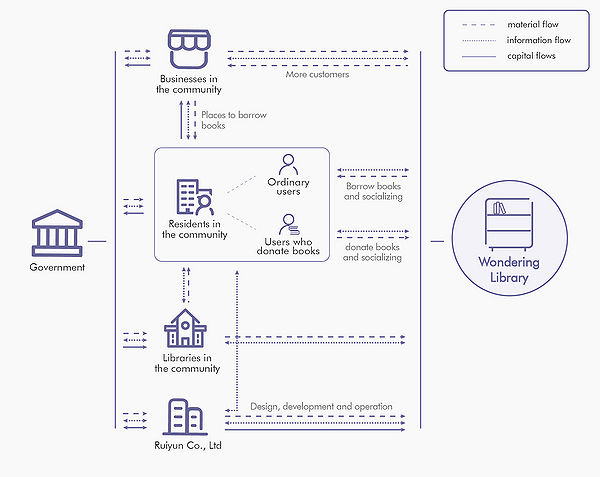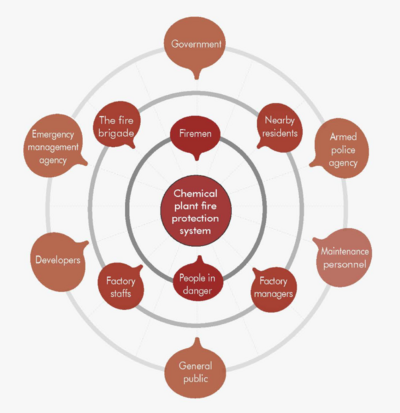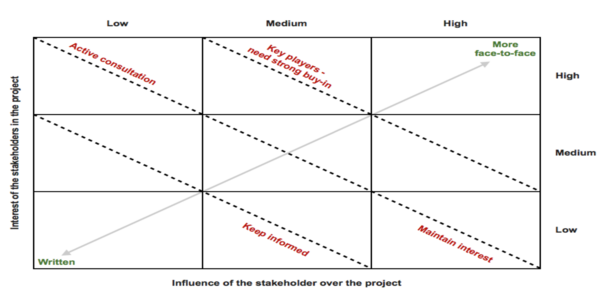Stakeholder Identification and Categorization
Ziwei Chen (Talk | contribs) (→Abstract) |
Ziwei Chen (Talk | contribs) |
||
| Line 2: | Line 2: | ||
== Abstract == | == Abstract == | ||
| − | + | ‘Stakeholders’ generally means any group or individual who can affect or is affected by the achievement of the organization’s objectives. (R. Edward Freeman’s (1984) Strategic Management: A Stakeholder Approach.) | |
| − | Stakeholder analysis is an essential part of project management. | + | |
| + | Stakeholder analysis is an essential part of project management, which can help recognize the people related to the project, so that project managers can analyze the impacts of different stakeholders, get more support and resources to facilitate the project. It is important to analyze stakeholders early in the project because it can provide a guide to decide the direction for a project. | ||
| + | |||
| + | This article explains how to identify and categorize the stakeholders by introducing the definition, purposes, applications, and limitations, aiming to provide readers with a guide to apply the methods. | ||
| + | |||
| + | |||
| + | |||
| + | |||
| − | |||
This article aims are mainly focus on first two steps. It begins with a brief definition of stakeholder, the purpose of identification and categorization of stakeholder It will then go on to how to identify and categorize stakeholders to optimize the progress of project management by scientific tools, and the limitations of it. | This article aims are mainly focus on first two steps. It begins with a brief definition of stakeholder, the purpose of identification and categorization of stakeholder It will then go on to how to identify and categorize stakeholders to optimize the progress of project management by scientific tools, and the limitations of it. | ||
| Line 11: | Line 17: | ||
== Definition == | == Definition == | ||
| − | ‘Stakeholders’ is generally understood to mean any group or individual who can affect or is affected by the achievement of the organization’s objectives(R. Edward Freeman’s (1984). Strategic Management: A Stakeholder Approach.) Stakeholders can be defined as actors who have an interest in the issue under consideration, who are affected by the issue, or who – because of their position – have or could have an active or passive influence on the decision-making and implementation processes<ref name='ref3'>Varvasovszky, Z. "A Stakeholder Analysis." Health Policy and Planning, vol. 15, no. 3, 1 Sept. 2000, pp. 338–345</ref>. | + | Stakeholder is a group, corporate, organization, member, or system that affects or can be affected by an organization's actions. <ref name = 'ref1'>Wikipedia Contributors. “Stakeholder.” Wikipedia, Wikimedia Foundation, 9 Oct. 2018, en.wikipedia.org/wiki/Stakeholder. Accessed 11 Dec. 2018.</ref>. |
| + | Stakeholders can also be defined as actors who have an interest in the issue under consideration, who are affected by the issue, or who – because of their position – have or could have an active or passive influence on the decision-making and implementation processes<ref name='ref3'>Varvasovszky, Z. "A Stakeholder Analysis." Health Policy and Planning, vol. 15, no. 3, 1 Sept. 2000, pp. 338–345</ref>. | ||
| + | |||
| + | Stakeholder analysis comprises different methods, processes and has developed a lot of tools utilized in different industrials and business structure. | ||
| + | Whatever approach is used, there are three essential steps in stakeholder analysis: | ||
| + | |||
| + | 1) Identifying the key stakeholders and their interests (positive or negative) in the project; | ||
| + | |||
| + | 2) Assessing the influence of, importance of, and level of impact upon each stakeholder; and | ||
| + | |||
| + | 3) Identifying how best to engage stakeholders | ||
| + | <ref name = 'ref2'>Golder, B, and Gawler, M. Cross-Cutting Tool Stakeholder Analysis. World Wildlife Fund, 1 Oct. 2005.</ref>. | ||
| + | |||
| + | |||
| + | |||
| + | |||
| + | |||
| + | |||
| + | |||
| + | |||
| + | ‘Stakeholders’ is generally understood to mean any group or individual who can affect or is affected by the achievement of the organization’s objectives(R. Edward Freeman’s (1984). Strategic Management: A Stakeholder Approach.) | ||
| + | |||
| + | Stakeholders can be defined as actors who have an interest in the issue under consideration, who are affected by the issue, or who – because of their position – have or could have an active or passive influence on the decision-making and implementation processes<ref name='ref3'>Varvasovszky, Z. "A Stakeholder Analysis." Health Policy and Planning, vol. 15, no. 3, 1 Sept. 2000, pp. 338–345</ref>. | ||
== Purpose == | == Purpose == | ||
| Line 30: | Line 58: | ||
=== Application === | === Application === | ||
[[File:Stakeholder_map_of_Chemical_plant_fire_protection_system.png|400px|middle|Figure 2: stakeholder map of Chemical plant fire protection system.]] | [[File:Stakeholder_map_of_Chemical_plant_fire_protection_system.png|400px|middle|Figure 2: stakeholder map of Chemical plant fire protection system.]] | ||
| − | |||
| − | |||
== Stakeholder map (interest / influence matrix) == | == Stakeholder map (interest / influence matrix) == | ||
| Line 39: | Line 65: | ||
=== Application === | === Application === | ||
[[File:Stakeholder interest influence matrix.png|600px|middle|Figure 2: stakeholder interest / influence matrix.]] | [[File:Stakeholder interest influence matrix.png|600px|middle|Figure 2: stakeholder interest / influence matrix.]] | ||
| − | |||
| − | |||
== System map == | == System map == | ||
| Line 51: | Line 75: | ||
The use of system map is a well-established tool in detect gaps and opportunities in a project. | The use of system map is a well-established tool in detect gaps and opportunities in a project. | ||
[[File:System map of urban decentralized library system.jpg|600px|middle|Figure 3: system map of urban decentralized library system.]] | [[File:System map of urban decentralized library system.jpg|600px|middle|Figure 3: system map of urban decentralized library system.]] | ||
| − | |||
| − | |||
== Limitation of stakeholder identification and categorization == | == Limitation of stakeholder identification and categorization == | ||
Revision as of 14:18, 11 March 2022
Contents |
Abstract
‘Stakeholders’ generally means any group or individual who can affect or is affected by the achievement of the organization’s objectives. (R. Edward Freeman’s (1984) Strategic Management: A Stakeholder Approach.)
Stakeholder analysis is an essential part of project management, which can help recognize the people related to the project, so that project managers can analyze the impacts of different stakeholders, get more support and resources to facilitate the project. It is important to analyze stakeholders early in the project because it can provide a guide to decide the direction for a project.
This article explains how to identify and categorize the stakeholders by introducing the definition, purposes, applications, and limitations, aiming to provide readers with a guide to apply the methods.
This article aims are mainly focus on first two steps. It begins with a brief definition of stakeholder, the purpose of identification and categorization of stakeholder It will then go on to how to identify and categorize stakeholders to optimize the progress of project management by scientific tools, and the limitations of it.
Definition
Stakeholder is a group, corporate, organization, member, or system that affects or can be affected by an organization's actions. [1]. Stakeholders can also be defined as actors who have an interest in the issue under consideration, who are affected by the issue, or who – because of their position – have or could have an active or passive influence on the decision-making and implementation processes[2].
Stakeholder analysis comprises different methods, processes and has developed a lot of tools utilized in different industrials and business structure. Whatever approach is used, there are three essential steps in stakeholder analysis:
1) Identifying the key stakeholders and their interests (positive or negative) in the project;
2) Assessing the influence of, importance of, and level of impact upon each stakeholder; and
3) Identifying how best to engage stakeholders [3].
‘Stakeholders’ is generally understood to mean any group or individual who can affect or is affected by the achievement of the organization’s objectives(R. Edward Freeman’s (1984). Strategic Management: A Stakeholder Approach.)
Stakeholders can be defined as actors who have an interest in the issue under consideration, who are affected by the issue, or who – because of their position – have or could have an active or passive influence on the decision-making and implementation processes[2].
Purpose
Stakeholder engagement can achieve mutual understanding and trust between the organization and the stakeholders in order to achieve a comfortable relationship of coexistence and mutual success
[4].
Stakeholder analysis can help project managers recognize the people related to the project and contact different stakeholders in suitable ways. Therefore, they can find opportunities to facilitate the process of a project and provide them with more comprehensive views to estimate risks that could happen in the future. But stakeholder engagement is also a complex process that needs to determine the scope, impact, and workload.
The tools to analyze stakeholders adopted for this article adapt to provide methods that quantify the information of stakeholders and straightened different stakeholders in a complex project.
Stakeholder map (circle style)
Introduction
Stakeholder map is a representation of all the stakeholder involved in a project, aimed at clarifying roles and relationships . [5] The activity of mapping stakeholders or “key connectors” is not only used to identify stakeholders but also to measure or predict their potential of influence and impact (Bourne and Walker, 2005; Walker, Bourne and Shelley, 2008).
Application
Stakeholder map (interest / influence matrix)
Introduction
Depending on the specific need, the map can be created as a simple quadrant with two axis (level of influence and level of interest or engagement in the process).
Application
System map
Introduction
A system map is a synthetic representation that shows in one single frame all the different actors involved in a service delivery, and their mutual links. The system map clarifies how the different service components and roles are connected one to the other, highlighting the values they exchange [6].
Application
The use of system map is a well-established tool in detect gaps and opportunities in a project.

Limitation of stakeholder identification and categorization
Feedback, however, is not always beneficial as it may influence and alter the stakeholder’s position, reducing the utility of the analysis. Feedback of outputs may also be inappropriate if the stakeholders are in a position to influence or control the outcome of the analysis, where a preliminary assessment is not favorable to them[2].
Conclusion
Stakeholder engagement has a large range, not all can be included and considered. The challenge for a project is to listen to the “right” stakeholders in the right way and make the right decision depending on the topic. This is especially relevant when it comes to corporate responsibility for sustainability. Balancing different interests, identify the types of stakeholders and deciding how to communicate with them is eventually forms the foundations for the result of the project.
References
- ↑ Wikipedia Contributors. “Stakeholder.” Wikipedia, Wikimedia Foundation, 9 Oct. 2018, en.wikipedia.org/wiki/Stakeholder. Accessed 11 Dec. 2018.
- ↑ 2.0 2.1 2.2 Varvasovszky, Z. "A Stakeholder Analysis." Health Policy and Planning, vol. 15, no. 3, 1 Sept. 2000, pp. 338–345
- ↑ Golder, B, and Gawler, M. Cross-Cutting Tool Stakeholder Analysis. World Wildlife Fund, 1 Oct. 2005.
- ↑ Mcphee, Wayne, and Sabrina M Dias. Integrating Sustainability into Major Projects: Best Practices and Tools for Project Teams. Hoboken, Nj, John Wiley & Sons, Inc, 2020
- ↑ Giordano Fanny, Morelli Nicola, De Götzen Amalia, Hunziker Judith. "The stakeholder map: A conversation tool for designing people-led public services", 2018
- ↑ Nicola Morelli, "New representation techniques for designing in a systemic perspective, paper presented at Design Inquires", Stokholm, 2007.

